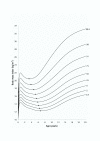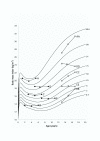Children grow and horses race: is the adiposity rebound a critical period for later obesity?
- PMID: 15113440
- PMCID: PMC394330
- DOI: 10.1186/1471-2431-4-6
Children grow and horses race: is the adiposity rebound a critical period for later obesity?
Abstract
Background: The adiposity rebound is the second rise in body mass index that occurs between 3 and 7 years. An early age at adiposity rebound is known to be a risk factor for later obesity. The aim here is to clarify the connection between the age at rebound and the corresponding pattern of body mass index change, in centile terms, so as to better understand its ability to predict later fatness.
Discussion: Longitudinal changes in body mass index during adiposity rebound, measured both in original (kg/m2) and standard deviation (SD) score units, are studied in five hypothetical subjects. Two aspects of the body mass index curve, the body mass index centile and the rate of body mass index centile crossing, determine a child's age at rebound. A high centile and upward centile crossing are both associated separately with an early rebound, while a low centile and/or downward centile crossing correspond to a late rebound. Early adiposity rebound is a risk factor for later fatness because it identifies children whose body mass index centile is high and/or crossing upwards. Such children are likely to have a raised body mass index later in childhood and adulthood. This is an example of Peto's "horse racing effect". The association of centile crossing with later obesity is statistical not physiological, and it applies at all ages not just at rebound, so adiposity rebound cannot be considered a critical period for future obesity. Body mass index centile crossing is a more direct indicator of the underlying drive to fatness.
Summary: An early age at adiposity rebound predicts later fatness because it identifies children whose body mass index centile is high and/or crossing upwards. Such children are likely to have a raised body mass index later. Body mass index centile crossing is more direct than the timing of adiposity rebound for predicting later fatness.
Figures



References
-
- Rolland-Cachera MF, Deheeger M, Bellisle F, Sempé M, Guilloud-Bataille M, Patois E. Adiposity rebound in children: a simple indicator for predicting obesity. American Journal of Clinical Nutrition. 1984;39:129–135. - PubMed
-
- Rolland-Cachera MF, Deheeger M, Bellisle F. The adiposity rebound: its contribution to obesity in children and adults. In: Chen C, Dietz WH, editor. In Obesity in childhood and adolescence. Philadelphia: Lippincott Williams and Wilkins; 2002. pp. 99–113.
-
- Rolland-Cachera MF, Deheeger M, Guilloud-Bataille M, Avons P, Patois E, Sempé M. Tracking the development of adiposity from one month of age to adulthood. Annals of Human Biology. 1987;14:219–229. - PubMed
MeSH terms
Grants and funding
LinkOut - more resources
Full Text Sources
Medical

